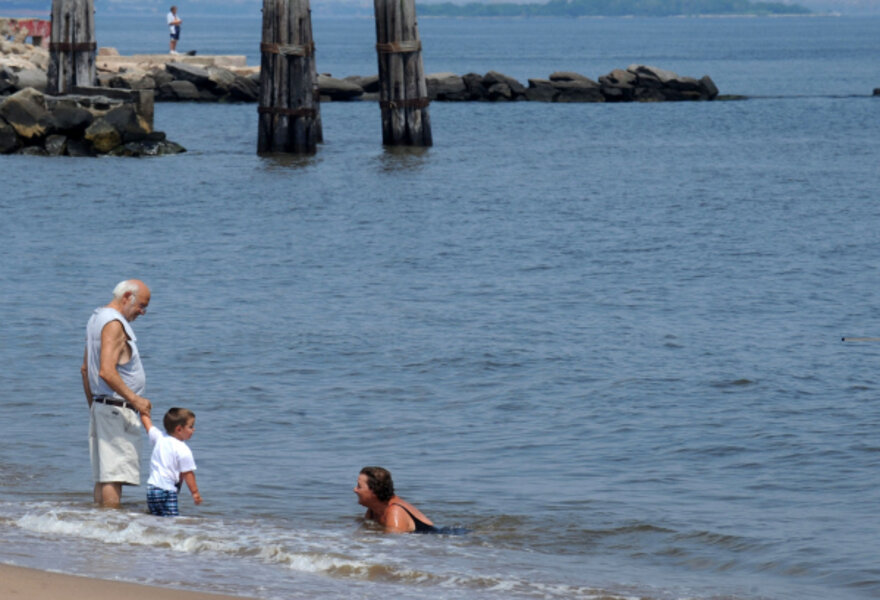Green solutions for New York City's overflowing sewers
Loading...
In late July, Harlem residents held their noses as millions of gallons of untreated sewage water flowed straight into the Harlem and Hudson Rivers because of a sewage plant fire. On the hottest day of the year, precious beaches and water areas were off limits, too toxic to swim in, as a repair team took shifts working in the heat to fix the plant.
But the crisis was more than just an isolated incident; it was symptomatic of a larger, structural problem in the way New York City – home to 8.5 million people – deals with its residents’ liquid waste.
Each year, 27 billion gallons of raw sewage are dumped into the New York City harbor, making sewage, or more specifically, the city's inability to process waste water, the largest source of water pollution in the city. This dumping is caused by combined sewer overflows that occur when the sewer system becomes overloaded by heavy rain on top of normal sewage flows. Overburdened city infrastructure is simply not capable of handing so much water.
The solution to this problem may lie in what is known as “green infrastructure.” Green infrastructure, according to the Department of Environmental Protection and PlaNYC, the city’s sustainability initiative, includes “advanced tree pits, porous pavements and streets, green and blue roofs.” It is essentially anything that is built in to the city’s currently existing infrastructure that makes systems, like sewage collection and treatment, run more smoothly.
Large-scale, industrial solutions, such as 50-million underground sewage storage tanks, are simply not affordable given New York City’s budget constraints. And the return on investment for these tanks is diminishing rather than growing according to PlaNYC. Therefore, other solutions must be taken seriously.
With green infrastructure, the city aims to reduce combined sewageo utflows by “manag[ing] runoff from 10 percent of the impervious surfaces in combined sewer watersheds through detention and infiltration source controls.” One tangible way to do this: the MillionTreesNYC campaign, which is planting trees throughout the city not only to provide shade, but also to create more treebeds that absorb rainwater.
But to many sustainability activists, the city’s green infrastructure plan is just a stop-gap measure, well-intentioned but too centralized and bureaucratic.
The approach of the Stormwater Infrastructure Matters (S.W.I.M.) coalition differs. The coalition views stormwater as a resource, rather than a waste. It wants to improve water quality through “natural, sustainable stormwater management practices in our neighborhoods,” according to its website. It has more than 70 member organizations working on infrastructural water issues in New York City.
After the recent North River sewage plant crisis, S.W.I.M. released news that the level of pollution in the Hudson River was much higher than the Department of Environmental Protection (DEP) had announced.
“Riverkeeper is one of our member organizations,” explained Kate Zidar, the coordinator of S.W.I.M. “They sampled in the middle of the river and near the shoreline; they did a comparative grid. It’s not totally clear to me how DEP tests; typically they test midstream. Riverkeeper found the pollution because they looked for it.”
What does this say about the DEP’s efforts to fulfill their responsibilities?
“Both the testing and the notification that is based on that testing is insufficient. It doesn’t meet their required duties,” Ms. Zidar said.
Zidar is critical of the DEP’s plans for stormwater management as well.
“The DEP is kind of creating their own definition of green infrastructure, which is confusing for people who have been in this field longer than they have,” she said. “They are using the term ‘green infrastructure’ to refer to what’s really stormwater detention.”
Detention refers to a process by which stormwater is held and then later released, decreasing the volume of water in the system. But retention, by contrast, is when water is retained and utilized. Retention, not detention, is what green infrastructure is based on, according to Zidar and others in the S.W.I.M. network.
“There are major flaws in the [city's] plan,” Zidar said. “We’re trying to make this better.”
In addition to the S.W.I.M. coalition, individual sustainability activists are taking matters into their own hands. One technology designer, Leif Percifeld, has invented a way for the NYC sewer system to “talk back” to New Yorkers, alerting them to storm events and system overflows.
Using Open Source coding and software, Mr. Percifeld made a sensor that can detect rising water levels and send text messages warning recipients not to use water at home. His next step is getting into the city’s sewers to install the sensors – no easy task, given that he’s doing it illegally and undercover. With the help of a canoe, a flashlight, and some mapping software, however, he is determined to make it happen. Anyone can sign up for the alerts through the Don’t Flush Me website.
Percifeld is acting to solve this problem as a citizen scientist, tackling a citywide infrastructural problem through grass-roots means: crowdfunding on a website to pay for materials, developing the technology on his own, and entering sewers without authorization.
Another citizen scientist team, Seeing Green, is embarking on a year-long research project to evaluate the potential of urban farms to become part of a city’s green infrastructure. Like Percifeld, Tyler Caruso and Erik Facteau are working at the grass-roots level, collaborating with people in their social network and employing their own know-how and resources to tackle the problem of burdened water systems. Caruso and Facteau would like for their research to nudge city officials into providing further support for urban agriculture.
Cleaning up the city’s waterways is a dirty job. But solutions are evolving from all levels – official citywide plans and grass-roots, collaborative efforts amongst concerned citizens. Moving forward, it will be vital that the lines of communication between all these actors are kept open so that affordable, sustainable solutions can go into effect as quickly as possible.






